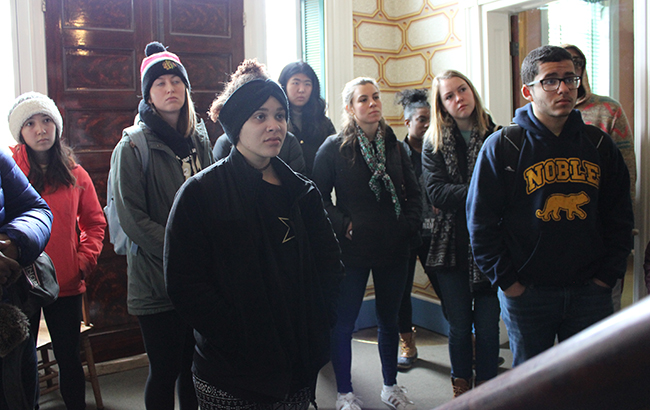Home » News » Race, Place and Power Students Visit Andrew Jackson’s Hermitage (Second Installment)
Race, Place and Power Students Visit Andrew Jackson’s Hermitage (Second Installment)
Posted by anderc8 on Wednesday, April 4, 2018 in News, Race, Place and Power.
On February 3, the students enrolled in the Race, Place and Power University Course visited Andrew Jackson’s mansion and plantation, commonly known as the Hermitage. They were accompanied by archeologist Larry McKee and specialist librarian Deborah Lilton. Larry has conducted excavations at the site that have unearthed valuable information about the slaves who lived and worked on the plantation and the hardships they faced. Deborah, meanwhile, provided important knowledge about slavery at the Hermitage in particular and the lives of enslaved Africans in the United States in general.
Over the next week or two, excerpts of some of the students’ responses will be available via this blog. These entries point out the problematic ways in which slavery and Jackson himself are portrayed at the Hermitage and highlight the need to approach the site through a critical, historically-informed lens.
Written by Carla Pax, Vanderbilt Class of 2019
Every detail placed in the Hermitage was situated so that the Jackson family became humanized. There were the little subtleties of the ironic wallpaper depicting Rachel’s favorite biblical rendition of the Odyssey, the fact that Jackson preferred the decorations in the left guest room over the one on the right and the banisters remaining from 1882. Jackson was portrayed as an influential man who entertained high-ranking officials. Missing were the details of his actions as a slave owner, or the slaughtering that occurred during the Trail of Tears. During the film, “The Oncoming Storm,” more time was dedicated to detailing the teasing that Rachel Jackson experienced than the thousands of deaths that occurred at Andrew Jackson’s hands. Even so, the narrative never shed light on the irony of Rachel Jackson having an extramarital affair and then adorning her foyer walls with the classic struggle of Odysseus’ and his fight against temptation.

The idealized story of Andrew Jackson culminated in the representation of Alfred’s cabin. Alfred was depicted as a slave of the Jackson family who stayed on as a tenant farmer after receiving his freedom. Alfred was used to present the idea that slave conditions were not the monstrosities that slaves and abolitionists made them out to be. His cabin has been on display since the 1800s. The historical inaccuracies present within the cabin lead me to believe that, like the rest of Jackson’s story, it was pieced together with forethought and false news.
I witnessed many visitors walking around a plantation where hogs would have been screaming, slaves beaten and inequality running rampant. Yet, for them, this was a family vacation. These children who visit the Hermitage will grow up to emulate a president who killed thousands of people for economic gain and will never be fully allowed to witness the true story. An accurate representation would be one that discusses everything about Andrew Jackson, from his positive achievements to the negative, dark and hateful things that he did. Erasing history just so that the presented “heroes” seem courageous and worthy is a lie. The best way to depict the truth is to offer the facts and allow people of the present and the future take all the evidence and define their own opinion about historical figures. The story presented at the Hermitage was an incomplete and false picture of Jackson’s life, and history can never be learned from it if is not accurately represented.
Written by Joi Boyd, Vanderbilt Class of 2018
Visiting the Hermitage was an engaging, enlightening, and at times disappointing experience for me. We were so fortunate to have Dr. Larry McKee and Ms. Deborah Lilton walking along with us to contextualize and further the conversations about the history and legacy of slavery. To begin our tour of the grounds, we started in Andrew Jackson’s mansion. Maybe it was the plastic tarps everywhere and the renovation projects they were conducting, but I was underwhelmed with the aesthetics of the house and the tour. When we moved outside and toured the grounds, the trip became much more engaging. Both Dr. McKee and Ms. Lilton were candid about how the Hermitage has historically done a poor job of talking about slavery.

I spoke with Ms. Lilton a lot while we were walking, and she contextualized some of the information we saw on the plaques placed near the slave cabins. She spoke about the story of the slave Alfred, for example, and how museum tour guides made a point to present him as being content with his life at the Hermitage. This brought us to larger discussions about some of the false narratives of slave life, including the myth of the “happy” slave who allegedly had no desire to escape. Dr. McKee also touched on the fact that when he worked at the museum, many years ago, they had far more slave artefacts on display than they currently have. It seemed obvious to me that the Hermitage didn’t try to pretend that slavery hadn’t happened, but they also did not instruct their guides on how to answer questions about slavery. As a whole, I thought the subject of slavery and the accounts of slave life were sloppily handled and misrepresented.
Finally, I enjoyed some of the conversations I held and overheard with other classmates. Everyone seemed to be curious and collectively frustrated at some of the things we saw, read and heard at the Hermitage. This brought us into broader discussions about contemporary race relations and power in the classroom, on college campuses, and in our different cities. I felt we bonded as a class as we got to know a little bit more about our own relations to the subject matter and how we hope to change things through learning experiences such as these.
